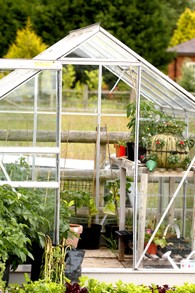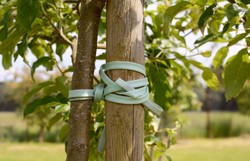I like where I garden. The soil is rich and deep,the ground is on the whole not prone to flooding, and we are not too concerned with pests, except those greedy wood pigeons that eat your cabbages and cauliflowers, but nets can stop them. However, I have said before that I garden in a wind tunnel, as the wind funnels between rows of houses to rush over my unsheltered spot. I am not high up, only seventy feet above sea level, but there is no protection. So how do gardeners cope with wind?
Well, ensure that your structures are well fastened together, fastened to the ground and safe. You also need to keep up regular maintenance. The greenhouse is a case in point. I had no defence against a mini vortex that took out some panes recently, but the frame held well. Why did it hold? I have it bolted down onto paving slabs and I reinforce it with pink grip cement, which is a powerful bonding agent, and I used several tubes of it.
You need to ensure that the frames are well fitted into place, so that none can be rattled by a strong wind. There is also a good case for allowing wind an escape route. If you think that is going to get in, allow it a way out, for otherwise it will blow its way out of the confined structure.
Poly-tunnels can be something of a lottery. I have seen some that stand up well against wind, but the cheaper, portable variety does not. I had one that was damaged by a storm,so I decided to fasten it down, lashing it to anchors with stout fastenings. The fastenings, though were too strong, stronger than the light metal frame, so they stayed firm, but the frame buckled. I had not factored that into the calculation. With hindsight,my conclusion is that temporary structures might be safer being taken down in Winter.
You might think of wind breaks. Surprisingly, solid walls are not the best defences against wind, which is why walled gardens like Heligan used to have shelter belts of trees outside the walls. While a wall gives protection for a distance up to ten times its height,the wind is deflected upwards by the walls and then becomes turbulent, which can cause some damage at times,particularly to roofs or tall trees. The ideal protection is a permeable barrier that allows some wind through but slows it. This can be a mesh fence or a hedge. Fences of fine mesh slow wind down to forty per cent of its speed and therefore, as damage is caused by the fastest winds, they prevent much damage. Some of my fellow plotholders surround their greenhouses with mesh or mats for about half the greenhouse height to prevent damage.
But thick hedges,maybe of privet,can be a great defence. These do not need to be high, in fact there can be lines of small hedges built at intervals through the garden, sometimes surrounding larger beds. Box is a great shrub for this purpose, but there is a bit of a problem that even hit Longmeadow,the garden tended by the renowned gardener and tv presenter Monty Don. The disease is box blight, a fungal disease that is invariably fatal and which results in the plant having to be pulled up and burned.










 TheThousand Year Gardenon 11/26/2025
TheThousand Year Gardenon 11/26/2025
 Women of the Gospelson 10/11/2025
Women of the Gospelson 10/11/2025
 Religious Gardenson 08/25/2025
Religious Gardenson 08/25/2025
 Doctor of the Church: John Henry Newmanon 08/03/2025
Doctor of the Church: John Henry Newmanon 08/03/2025



Comments
Correct. I was using the British term for a water barrel..
Thank you!
The second paragraph to the fourth subheading, Drought, defers to "water butts."
Might the aforementioned term be different from or the same as the Unitedstatesian term rain barrel?
It does not rain every other day in the UK, but there are times of year when rain is more frequent. Where I live, Manchester, got a reputation as a rainy city, but I think its reputation is not deserved. On the other hand when I lived for a year in Ireland, in March it did rain every day, even if it was a minor shower.
Thank you!
Bright sunlight can be problematic in some places, such as desert states such as Arizona or Nevada or New Mexico and such as Alaska.
Is the United Kingdom like Washington state, where it rains every other day if not sometimes days in a row?
In Britain bright sunlight is rarely much of a problem.
The introductory paragraph advises us that "there are issues with wind, drought and flood, all of which need to be protected against."
What about bright, strong sunlight?
Thank you!
Some Unitedstatesians opt for such liquid fertilizer as compost tea.
Would you ever have used compost tea? If so, would you apply it in the morning or in the evening?
I prefer watering in the morning, as doing so makes water available during day time. But in Crete our hotel had much fruit growing and the gardener always watered at night, and it was a successful and productive garden.
The fourth paragraph under your next-to-last subheading, Drought, comments that "I do not like to spray the leaves when watering in hot weather, it is much more productive to direct the water to the roots of the plant, which can be done by aiming the hose at the base of the stem. Not only does this mean that water is prevented from disappearing directly by evaporation, but it prevents the moisture build up on leaves that can aid the growth of fungal pathogens."
A controversy on this, western Atlantic-pond side is the watering time.
Would you hose, spray or sprinkle water in the morning so that plants don't spend their nights with their roots wet?
Or would you water in the evening so that plants lose the least amount to evaporation?
Vermiculite is well-known for retaining and slowly releasing water, though I don't really need it at the moment. I last used it a long time ago.
That your egg plants burned is astounding, for they are warm weather plants. Where I am, an egg plant is unlikely to burn, so you certainly garden in climes warmer than I do. We rarely reach the upper nineties. Today I tolerated the gusting wind and not very warm temperature, but went home when the rain started. But that's England!